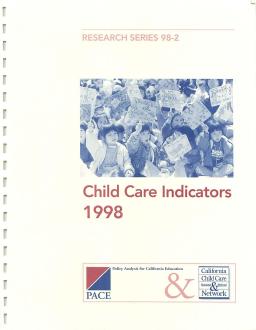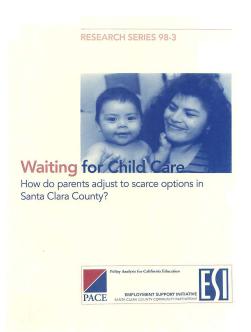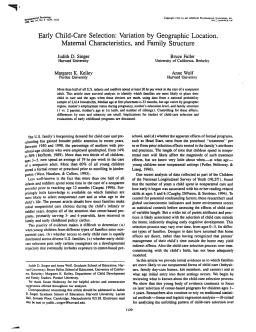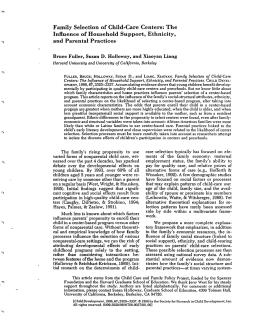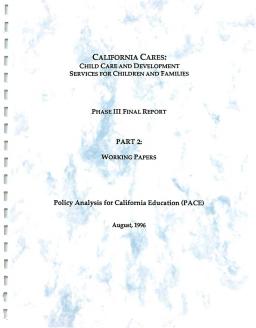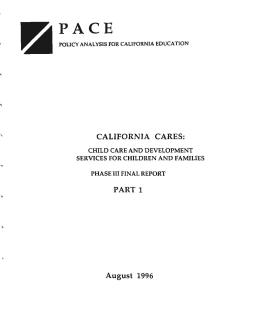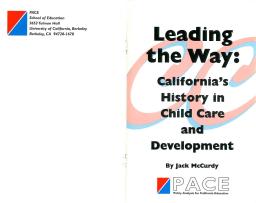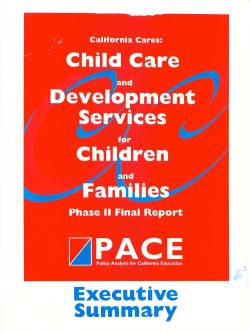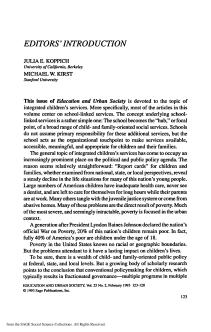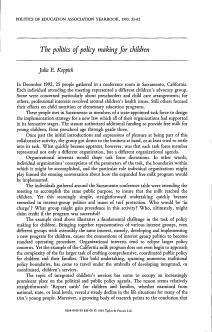Published
Summary
The report provides local and state-level policymakers with data on the current capacity of the childcare system and indicators of future growth in family demand. It includes county-level aggregates, new data on job-related income, and estimates for families earning less than 75% of California's median income. It also adds new data on the size of the childcare workforce in each county, revealing disparities in the availability of childcare services and the number of local residents depending on the industry for their livelihood.
Preliminary Figures
Published
Summary
California's childcare system lacks planning capacity and data on supply and demand. The Child Care Indicators 1998 report provides early indicators of supply and demand for all zip codes statewide, but zip codes may not reflect local residents' own definition of their community. Public funding for childcare and preschool programs will double in California between 1996 and 1999, but targeting new funding to areas with the greatest need remains a challenge.
How Do Parents Adjust to Scarce Options in Santa Clara County?
Published
Summary
In 1998, the PACE research center surveyed low-income and blue-collar parents to help streamline the process of finding childcare, in response to the state's welfare reform legislation. The survey included 300 in-depth interviews and covered topics such as employment, searching for childcare, interim childcare, and perceptions of care quality. The report addresses the policy problem and how parents perceive their limited childcare options.
Variation by Geographic Location, Maternal Characteristics, and Family Structure
Published
Summary
This article uses survival analysis to examine factors associated with placing infants and toddlers in nonparental care, and at what ages. Using data from a national probability sample of 2,614 households, the study finds that the median age at first placement is 33 months and varies by geographic region, mother's employment status during pregnancy, education level, and family structure. Differences by race and ethnicity are small. The article discusses implications for studies of childcare selection and evaluations of early childhood programs.
California Families Face Gaps in Preschool and Child Care Availability
Published
Summary
This report highlights the unequal distribution of preschool and childcare opportunities in California. Despite spending $1.2 billion annually, half of preschool-age children live in households with working mothers, with enrollment dependent on income and location. Counties vary greatly in their supply, with affluent parents more likely to find preschool or childcare slots. Latino children are hit hardest, even in counties with ample supply, with supply in predominantly Latino areas half that of low-income Black or Anglo communities.
The Influence of Household Support, Ethnicity, and Parental Practices
Published
Summary
An investigation of the family factors and practices that influence parents' choice of center-based programs for young children. Maternal education, child's age, and availability of social support were found to be significant factors in center selection. African-American families were more likely to choose center-based care than white or Latino families, and parental practices related to early literacy development and close supervision also affected center selection. The study highlights the importance of considering selection processes when assessing the effects of early childhood programs.
Child Care and Development Services for Children and Families—Phase III Final Report, Part 2
Published
Summary
Phase III of the California Cares report sought to analyze preliminary recommendations and involve the childcare and development community to redesign policies. Work groups and field representatives discussed proposals for improving services, with over 80 contributors. The project studied nine critical policy restructuring questions and Part Two of the report includes reports from eight tasks and summary information.
Child Care and Development Services for Children and Families—Phase III Final Report, Part 1
Published
Summary
Phase III of the California Cares report aimed to redesign childcare and development policy, with input from the community and representatives from three agencies. Work groups and traditional research projects were conducted to study nine questions deemed critical to policy restructuring. Part II of the report includes working papers for all tasks except state governance, which is included in Phase III.
California's History in Child Care and Development
Published
Summary
New curriculum manuals have been created to address the expanding field of school-age childcare, including Kids' Time: A School-Age Care Program Guide. Other widely-recognized materials include Just Kids, Preparing for Mass Disasters, and A Guide for Training and Recruiting Child Care Providers to Serve Young Children with Disabilities. The benefits of childcare include fully-employed parents, self-sufficient families, and children who succeed in school due to the aid of childcare programs. Reducing Exceptional Stress and Trauma, a guide on coping with violence, will be published this year.
Child Care and Development Services for Children and Families—Phase II Final Report Executive Summary
Published
Summary
The California Cares Project, conducted by PACE for the California Department of Education, Social Services & Office of Child Development & Education, culminates in this report. The project was initiated in response to AB 2184, which sought to consolidate all childcare and development programs to streamline the system. The report is divided into two parts: Part I analyzes current obstacles to a seamless system and Part II presents a conceptual model and decision procedure for program and funding allocation and governance. Phase III will refine recommendations and work towards implementation.
Child Care and Development Services for Children and Families—Phase I Final Report
Published
Summary
The California Department of Education, Social Services, and Governor's Office of Child Development and Education selected PACE to analyze issues and options for improving California's childcare system. PACE will produce a report with optional approaches for improving access, quality, and funding of childcare services, including alternative systems and policy models. Phase I includes analysis of childcare issues and programs, literature reviews, and experiences of other urban states. This report summarizes Phase I's work.
Editors' Introduction
Published
Summary
The concept of school-linked services is to make social services available to children and families through the school acting as an organizational touchpoint. This idea has become increasingly prominent due to the declining life situations of many American children, particularly those in urban areas, who face poverty-related issues like inadequate healthcare, juvenile justice involvement, and abusive homes.
Published
Summary
The politics of policy making for children is complex due to the multiple interest groups involved. Fragmented policies exacerbate the problem of declining life situations for children. A comprehensive children's policy is needed, but traditional interest-group approaches to policy development must shift to integrate services for children. California's politics of children's policy is briefly explored. The current political paradigm must fundamentally change to open policy doors for broad-based integrated services for children.
Published
Summary
School finance has become a prominent issue again due to court decisions and litigation in several states. This article explores school finance changes in the 70s and 80s and outlines key issues for the 90s, including the relationship between finance and education goals, site-based management, teacher pay, accountability, school choice, and nontraditional issues such as preschool and non-educational services for children.
Overcoming Barriers, Creating New Opportunities
Published
Summary
This article highlights the changing nature of childhood, with increasing physical and mental health problems, substance abuse, child abuse, inadequate child care, and family disorganization. Furthermore, schools struggle to meet the needs of non-middle-class, nonwhite, non-English-speaking children, as more students from these backgrounds enter public schools. To improve educational prospects, school leaders must recognize how children's daily lives affect their education and adapt to these changes.

